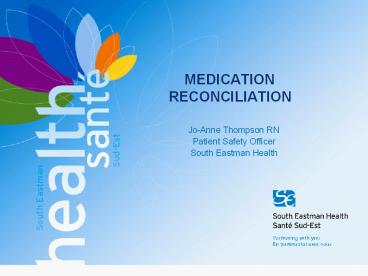MEDICATION RECONCILIATION - PowerPoint PPT Presentation
1 / 20
Title: MEDICATION RECONCILIATION
1
MEDICATION RECONCILIATION
- Jo-Anne Thompson RN
- Patient Safety Officer
- South Eastman Health
2
WHO ARE WE?
There are 11 regional health authorities in
Manitoba.
3
SOUTH EASTMAN RHA
population 66,984 (6 of MB)
Source Manitoba Health (June 2009)
4
PERSONAL CARE HOME BEDS
N 334
St. Adolphe 42
4
5
SOUTH EASTMANS MED. REC. STEERING COMMITTEE
- Jo-Anne Thompson (Chair) - Patient Safety Officer
- Jan Gunness (Executive Sponsor) - Manager of
Quality Corporate Planning - Cecile Dumesnil- Regional Director of Pharmacy
- Lothar Dueck Pharmacist
- Dr. S. Migally Physician
- Brenda Barkman Clinical Resource Nurse (CRN)
Rehab Unit - Donna Bella Home Care Case Coordinator
- Charleen Barkman Staff Development
Coordinator-LTC - Shirley Bezditny Staff Development Coordinator-
Acute Care - Tannis Nickel-Director of Nursing (DON) Rest
Haven Nursing Home - Public Health, Mental Health (Reps needed)
6
WHAT ARE WE TRYING TO ACCOMPLISH?
- Develop and implement a regional Medication
- Reconciliation process throughout the continuum
of care, which will help prevent medication
errors from occurring and reduce the potential
for harm to patients. - It has started in Acute Care (Phase I) and will
continue to spread to all other areas of service
i.e.) Long Term Care, Home Care, Community etc - Phase II commenced Spring 2009.
- Pilot site Rest Haven Nursing Home.
7
HOW WILL WE DO THIS?
- PDSA ( Plan-Do-Study-Act) Improvement Model
- PLAN Creating forms that work within South
Eastman Health - DO Testing the forms on the pilot sites
- - Rest Haven Nursing Home (LTC)
- STUDY Evaluating and modifying the forms.
- ACT Implementing changes on the forms and
planning for the next cycle.
8
HOW WILL WE KNOW WE ARE MAKING A DIFFERENCE ?
- The team is currently performing baseline chart
audits in order to measure our successes. - Discrepancies between the home medications and
the admission orders are measured. - The goal of the Med.Rec. project is to reduce
these discrepancies over time. Ongoing testing
will occur at various points of the project to
assess the impact of the Med.Rec. process.
9
WHAT ARE WE MEASURING?
- No discrepancies
- Intentional discrepancies Physician has made an
intentional choice to add, change or discontinue
a medication and is clearly documented. - Undocumented Intentional Discrepancy Physician
has made an intentional choice to add, change or
discontinue a medication but this choice is not
clearly documented. i.e) Nitro-patch put on hold
or discontinued but no reason given. This
captures the accuracy in documentation - Unintentional Discrepancy Physician
unintentionally changed, added or omitted a
medication the patient was taking prior to
admission. This reflects the errors that
inadvertently occur when writing orders. - The primary goal is to eliminate the undocumented
intentional and unintentional discrepancies
through the medication reconciliation process.
10
GOAL
- The area of focus will be to decrease the mean
of undocumented intentional discrepancies on
patients admitted to the hospital LTC
facilities by 75, as well as the unintentional
discrepancies by 75.
11
SO HOW DO WE KNOW THAT WE ARE SUCCEEDING?
- To know that we are succeeding in LTC the
undocumented unintentional discrepancies will
need to meet the set goal line over 6 consecutive
months to master this process. - LTC is tracking the percentage of residents
reconciled at admission which coincides with
Accreditation Canada standards which is 100.
12
(No Transcript)
13
(No Transcript)
14
(No Transcript)
15
What Does the Audit results reveal for our 4
sites.
16
POSITIVE GAINS WITH THE PROCESS
- Earlier identification of issues with patient
home medications - Developed a Medication Risk Assessment Tool used
on admission that engages Pharmacists by referral - Increased documentation of allergies
- Decreased duplication in recording medication
histories - (Both for Physician Nurse)
- Improved communication of medication histories to
all disciplines - Improved communication to next healthcare
provider for changing or not ordering home
medications
17
CHALLENGES
- As we progress in spread challenges may present
it self. The steering committee team will work on
resolving issues on a ongoing basis. - Continuous Education for all new employees hired
18
SOUTH EASTMAN HEALTH
- Team work involves the Patient/Client/Families,
Nurses, Physicians and Pharmacists - Working as a team in South Eastman Health we can
make a difference by improving patient safety and
reducing potential adverse outcomes of care
related to medications
19
REFERENCES
- Canadian Patient Safety Institute
- Manitoba Institute for Patient Safety
- Safer Healthcare NOW!
20
(No Transcript)































